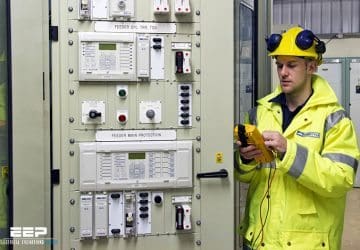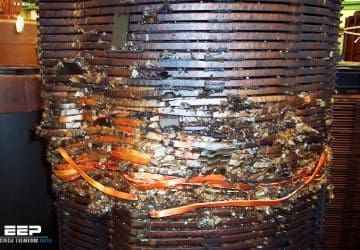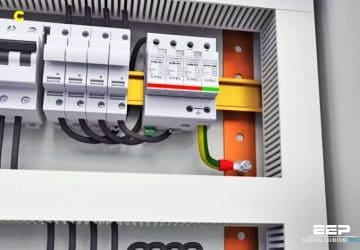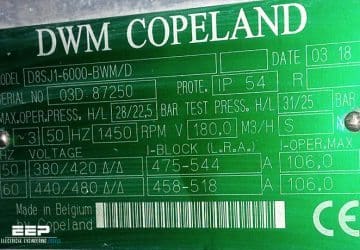The basic calculation of transmission line protection
The excessive currents accompanying a fault, are the basis of overcurrent protection schemes. For transmission line protection in interconnected systems, it is necessary to provide the desired selectivity such that relay operation results in the least service interruption while isolating… Read more
Dec 16, 2016 | By Edvard Csanyi

The principles of differential protection you MUST understand
Although nowadays differential protection is achieved numerically, in order to understand the principles of differential protection it is useful to analyze the ubiquitous electromechanical relay. Figure 1 shows a simple differential protection scheme, also known as a Merz-Price scheme. In this… Read more
Dec 09, 2016 | By Edvard Csanyi

5 transformer fault conditions and how to protect from them
A number of transformer fault conditions can arise practically in any time following some special situations. These include the following five most common internal faults and few external: earth faults, core faults, interturn faults, tank faults, and external factors. Table… Read more
Nov 23, 2016 | By Edvard Csanyi

Protection from fault current by automatic power supply disconnection
The use of protective conductors linking all the exposed conductive parts of all equipment creates a circuit called the “fault loop” designed for circulation of the fault current that arises following an insulation fault. The fault current may or may… Read more
Nov 21, 2016 | By Edvard Csanyi

Five key factors to the correct cable selection and application
It is essential to know cable construction, characteristics, and ratings to understand problems related to cable systems. However, to correctly select a cable system and assure its satisfactory operation, additional knowledge is required. This knowledge may consist of service conditions,… Read more
Oct 31, 2016 | By Edvard Csanyi

Tips for power factor correction and good protection of capacitors
Loads such as induction motors draw significant reactive power from the supply system, and a poor overall power factor may result. The flow of reactive power increases the voltage-drops through series reactances such as transformers and reactors, it uses up… Read more
Oct 26, 2016 | By Edvard Csanyi

How electricians choose the most suitable protection devices
There are at least four main issues electricians must take care off very carefully when choosing the most suitable protection devices. Of course, there are dozen of other issues, but let’s try to define the most important ones from the aspect of… Read more
Oct 21, 2016 | By Edvard Csanyi

Practical tips for installation and using of thermistor motor protection
Thermistor is a small non-linear resistance sensors, which can be embedded within the insulation of a motor winding, to provide a close thermal association with the winding. It’s made from a metal oxide or semiconductor material. The relationship between resistance… Read more
Oct 14, 2016 | By Edvard Csanyi

Guidelines for good consumer unit design and low electric fields in the house
The consumer unit is the “fuse box” which goes between the electricity meter and all the electrical circuits in the house. Modern units do not contain fuses, but miniature circuit breakers (MCBs) which have replaced them. They often also contain… Read more
Oct 10, 2016 | By Edvard Csanyi

Best practice for using surge protective devices (SPDs) and RCD together
Where the power distribution system incorporates RCDs transient activity could cause RCDs to operate and hence loss of supply. Surge protective devices (SPDs) should wherever possible be installed upstream of RCD to prevent unwanted tripping caused by transient overvoltages. Where… Read more
Oct 07, 2016 | By Edvard Csanyi

What is grounding and why do we ground the system and equipment?
The term grounding is commonly used in the electrical industry to mean both “equipment grounding” and “system grounding”. Equipment grounding means the connection of earth ground to non-current carrying conductive materials such as conduit, cable trays, junction boxes, enclosures, and motor… Read more
Sep 14, 2016 | By Edvard Csanyi

What a ground fault circuit interrupter does and what it does not do
A ground fault circuit interrupter (GFCI) monitors the current balance between the ungrounded “hot” conductor and the grounded conductor. As soon as the current flowing through the “hot” conductor is in the range of 4 to 6 milli-amperes more than the… Read more
Sep 09, 2016 | By Edvard Csanyi

4 essential implementations of protective relays in power systems
In this technical article, protective relays are categorized depending on the component which are protect: Generators Transmission lines Transformers, and Loads There are different protection schemes used for protecting generators depending on type of fault to which they are subjected…. Read more
Sep 05, 2016 | By Edvard Csanyi

Breaking of a short circuit current in a direct current system
Direct current presents different problems than alternating current with aregard to the phenomena associated to the breaking of a short circuit current and interruption of other types of high value current since the arc extinction results to be particularly difficult…. Read more
Aug 29, 2016 | By Edvard Csanyi

What details a motor nameplate shows and how to use them
We have all seen the motor nameplate attached on the motor side (or on top). All motors have a permanent nameplate which lists all important data, further data is usually available in the motor catalogue. It is important to recognize… Read more
Aug 26, 2016 | By Edvard Csanyi


